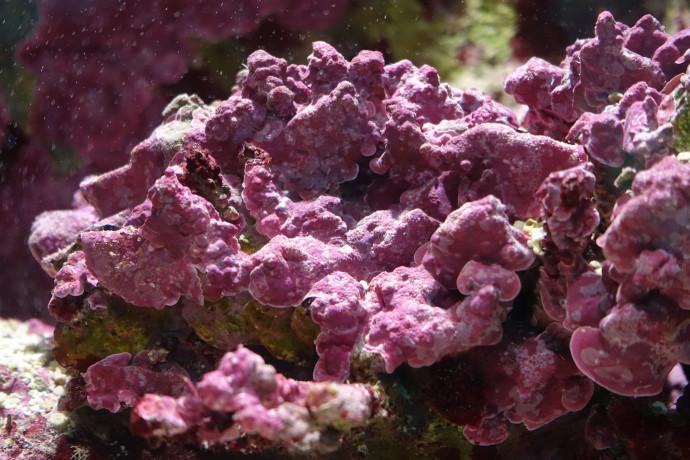

Coralline Algae: Tips To Easily Remove From Equipment

When it comes to saltwater and reef aquariums, coralline algae is a familiar sight. It brightens up live rock with shades of pink or purple, adding an appealing aesthetic touch. However, its tendency to grow on the inside walls of your aquarium and equipment can present a challenge, especially given its hard calcareous deposits within its cell walls.
Understanding Coralline Algae in Aquariums
-
Coralline algae add a splash of color to live rock in saltwater and reef aquariums, turning the dull, natural appearance into vibrant shades of pink or purple.
-
Besides live rock, coralline algae will also grow on the aquarium's inner walls and equipment.
-
Unlike other types of algae, coralline algae has calcareous deposits within its cell walls, making it difficult to remove.
Removing Coralline Algae from Glass Aquariums
-
Use an algae scraper with a stainless steel blade to remove coralline algae from glass aquariums.
-
Regular cleaning can prevent algae buildup, making removal easier.
-
Be careful while scraping around the aquarium's seams to avoid peeling off the silicone glue.
-
For quality scraping tools, hygger Carbon Fiber 6 in 1 Aquarium Cleaning
Tool Kit (https://www.amazon.com/Hygger-Aquarium-Telescopic-Saltwater-Freshwater/dp/B07MB183VL?tag=aquaticexcom-20) or Algae Scraper for Glass Aquariums (https://www.amazon.com/SINLASA-Aquariums-Aquarium-Scrapers-Stainless/dp/B08ZJCJB9X?tag=aquaticexcom-20) are quality options.
Keeping Your Aquarium Equipment Clean
It's not just the walls of your aquarium that can end up covered in coralline algae. Submerged equipment, including powerhead covers, can also become encrusted. These covers, which have slots to allow water flow and prevent livestock from getting in, become less efficient when the algae slowly covers these slots. Cleaning Equipment Ensures Proper Function and Appearance.
Citric Acid Aquarium Equipment Cleaner:
Citric acid is a safe and incredibly effective solution for dissolving coralline algae buildup on aquarium equipment. Simply mix 4 tablespoons (2 oz) of citric acid with 1 quart of RO/DI water until fully dissolved, then soak your equipment for easy removal. Always follow manufacturer directions carefully for best results and safety for you and your equipment. OR Distilled White Vinegar Solution. Regular distilled white vinegar creates an effective cleaning solution that dissolves encrusted coralline algae and calcium deposits from aquarium equipment. Choose the appropriate concentration based on your cleaning needs:·
For heavily encrusted equipment: Mix a 50/50 water and distilled white vinegar solution (1:1 ratio) and soak for 1-2 hours
For moderate buildup: Use a 25% vinegar to 75% water ratio (1:3 ratio) for lighter cleaning jobs.
For stubborn deposits: Use 100% white vinegar for short soaks (30-60 minutes), but exercise caution with plastic components as full-strength vinegar may damage some materials. After soaking, the algae buildup will easily flake away when scrubbed with a brush - just be sure to thoroughly rinse all equipment before returning it to your tank. Brushing May Still Be Necessary After soaking, some coralline algae and calcium buildup may remain on your equipment. Use nylon bristle brushes to scrub pumps, powerheads, and plumbing. For tight spaces, corners, and small components, toothbrushes or aquarium detailing brushes work best.
For those looking to work smarter, not harder, consider theOXO Good Grips Deep Clean Brush Sethttps://www.amazon.com/OXO-Grips-Clean-Brush-Orange/dp/B003M8GMS6?tag=aquaticexcom-20these brushes have Tough bristles with small precision heads.or Aquarium Filter Brush Set, Flexible Double Ended Bristles Hose Pipe Cleaner with Stainless Steel Long Tube Cleaning Brush and 10 Pcs( https://www.amazon.com/Aquarium-Flexible-Bristles-Stainless-Different/dp/B07PGFDY7R?tag=aquaticexcom-20)This is a multi-brush set for ornaments, rocks, tubing, and other equipment. Or API Aquarium Pharmaceuticals 44 Hand Held Pad for Acrylic Aquariums (https://www.amazon.com/API-Acrylic-Aquariums-1-Count-Container/dp/B000255NI2?tag=aquaticexcom-20)
this is a Non-abrasive pads for cleaning algae off decorations and tank walls.
Tip: Routine cleaning helps prevent performance issues and prolongs the life of your equipment. Some components may need to be disassembled to ensure all deposits are thoroughly removed.
FAQ's
How often should I clean my aquarium to prevent coralline algae buildup?
Weekly cleaning prevents stubborn buildup and makes removal easier. Frequency may vary based on your aquarium's specific conditions and growth rate.
Can I use the same scraper for both glass and acrylic aquariums?
No. Glass aquariums require stainless steel blade scrapers, while acrylic aquariums need plastic blade tools to prevent scratching. Kent Marine's Short Pro-Scraper with a plastic blade works well for acrylic tanks.
Are citric acid and vinegar solutions safe for all aquarium equipment?
Both solutions are safe for most materials including plastic, ceramic, rubber, and PVC. However, full-strength vinegar can damage some plastic components, so start with diluted solutions for sensitive materials. Always rinse equipment thoroughly before returning it to your aquarium, and test on a small area first if unsure about material compatibility.
Dependable Products For All Types Of Aquariums and Ponds
Join the CLUB for new videos, discount codes, and more!
Join The Club for A 15% OFF Coupon
Aquatic Experts provides simple solutions, tested products, and expert information to aid aquarium and pond hobbyists in creating exceptionally beautiful, healthy aquariums and ponds.


